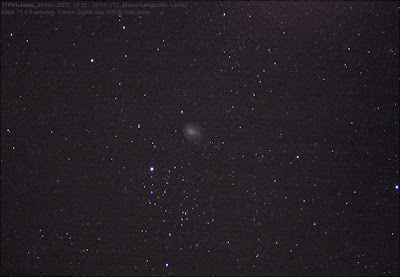Short but bright clearings between hailshowers late last evening allowed me to image comet 17P/Holmes again. It still is a naked eye object, and still growing rapidly. It was notably larger yesterday than
4 days before.
Below is a stack of 16 images exposed 5 seconds each with the Canon Digital Ixus 400 on a fixed tripos and maximum optical zoom (3x):
(click image to enlarge)

A false-colour version of this image draws attention to a slightly curved jet of gas flowing outwards (direction to the lower right in the image), and the egg-shaped coma (hint of a tail onset) that is the result:
(click image to enlarge)
Below, I have combined last evening's image with that taken 4 days earlier, to show not only the movement but also the visibly growing coma diameter in these 4 days time:
(click image to enlarge)

Next I used ASTRORECORD to measure the size of the coma on both images (these sizes were taken at an angle perpendicular to the sun-comet line). As the distance to the comet for these two dates is know, this allows a calculation of the actual size of the gas coma in km/miles. Last evening, this was 1.6 million km, or 1.0 million miles, growing at a rate of about 55 000 km/day or 2000 km/h:
date___________ _size____true size (km)__ _(miles)
2007 Nov 7.96___19.6’__ 1.380 million___0.862 million
2007 Nov 11.90__22.6’___1.599 million___0.999 million





















